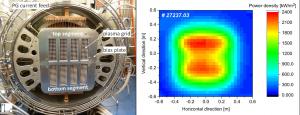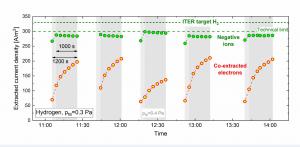How ELISE is contributing to ITER
ITER's neutral beam injection system is based on a radio frequency source that has been the subject of decades of development in Europe. At Max Planck Institute for Plasma Physics (IPP) in Garching, Germany, an upgrade to the ELISE half-size source testbed will allow scientists to proceed further along the road to demonstrating ITER source requirements in complement to the full-size source under development at the ITER Neutral Beam Test Facility.
The basic principle behind ITER's most powerful heating system is relatively simple: fast (>10,000 km/s) hydrogen or deuterium atoms are injected through the tokamak magnetic field cage into the plasma, where they transfer their energy to the plasma particles through collision.
The physics and technology behind the production of fast atoms is much more complex, however, as beams of neutrals are always created by accelerating ions to high energy and then neutralizing them by adding or removing an electron on the fly.
Most of the complexity is concentrated in the plasma sources where hydrogen ions are generated. They flow towards a first electrode and then venture out in a high electric field region were they will acquire their speed. The challenge for the ITER sources is that the required beam energy (1 MeV) imposes the use of negative ions, which have a better neutralization efficiency than the positive ions used the neutral beam injection systems of most other fusion devices.
Inside the source, the negative ions are surrounded by plasma electrons that have the same charge. Therefore, the positive potential applied to extract and accelerate the ions causes the unwanted co-extraction of electrons which get scattered inside the accelerator, causing an enormous heat load to the system.
The ion source is thus required to produce large and stable flux of negative ions while keeping the electron current low enough (a ratio of electron current to ion current of less than one is mandatory). The ITER source requirements in this sense are the most stringent ever, and it is only thanks to the continuous efforts of several laboratories around the world that the performances required the ITER neutral beam injection are finally within reach.
The ELISE test bed
Over the last two decades, the neutral beam injection group at the Max Planck Institute for Plasma Physics (IPP) has had a leading role in contributing to such efforts. The design of IPP's 1/8-scale (relative to ITER) prototype source BATMAN was a true game-changer back in the early 2000s. Compared to the alternative technology at the time for negative ions—a source based on the heating of a tungsten filament—BATMAN's technology introduced radiofrequency (RF) waves injected through an external antenna to generate the plasma. It proved to be maintenance-free and reliable, removing the issue of filament lifetime, and was readily chosen as the baseline design for the plasma production in the ITER negative-ion-based neutral beam injection source.
Since then, research has continued at IPP on the ELISE test rig (for Extraction from a Large Ion Source Experiment), which features an ion source one-half as large as ITER's. The goal for ELISE has been to push forward the source performances in terms of extracted ion current and stability over time. The first goal was achieved for hydrogen last year after four years of regular improvements in the device.
The full achievement of the second requirement has been limited so far by the power supply available to ELISE, but that is about to change.
In ITER, a stable power flux (i.e., a stable ion current from the source) lasting up to 1 hour is required. Sustaining the plasma for this extremely long time is nowadays routinely achieved at IPP, but the beam duration has been limited up to now by the available hardware. The particles in the source could be continuously generated and made ready for the take-off but—due to power sources that could only generate the required electric fields in a pulsed fashion—they could only be accelerated for 10 s every 3 minutes.
Using the current power sources IPP has been able to demonstrate the possibility of extracting reproducible, high-current beams of hydrogen. This satisfies the requirements of the heating neutral beam injectors for the first (non-nuclear) phase of the ITER research program. But in the nuclear phase, when a mixture of deuterium and tritium will be used to produce net energy, neutral beams of deuterium will be required.
When operating the ELISE ion source with deuterium, the extracted negative ions show reasonably good stability but—due to pulsed extraction—the current of co-extracted electrons is everything but stable: a dramatic increase pulse after pulse and within the pulse is observed, thus limiting the source performance. In order to study the temporal dynamics of ITER relevant currents without the difficulty of a pulsed beam, the decision has been taken to install a steady state power supply on ELISE.
The power supply has already been ordered and is expected to be commissioned early next year. The EUROfusion consortium is contributing to its cost in conjunction with IPP with the long-term view that the next phase of experiments at ELISE will also support the design of the future negative ion sources for DEMO, the fusion device that is planned after ITER.
After this considerable upgrade the ELISE testbed will be able to proceed further toward meeting the remaining ITER source requirements, and complement the ITER test facility ion source development which is carried out at SPIDER.
Click here to view a video of pulse #27316 filmed from three different angles (the camera looking at the plasma, the infrared camera looking at the copper calorimeter, and the camera looking at the tungsten-wire calorimeter).



